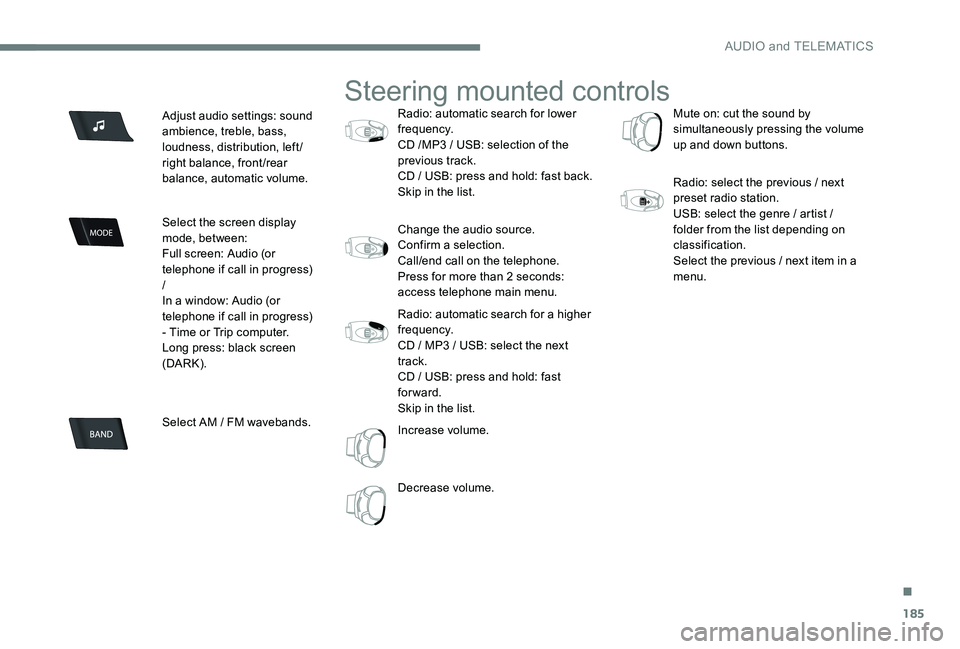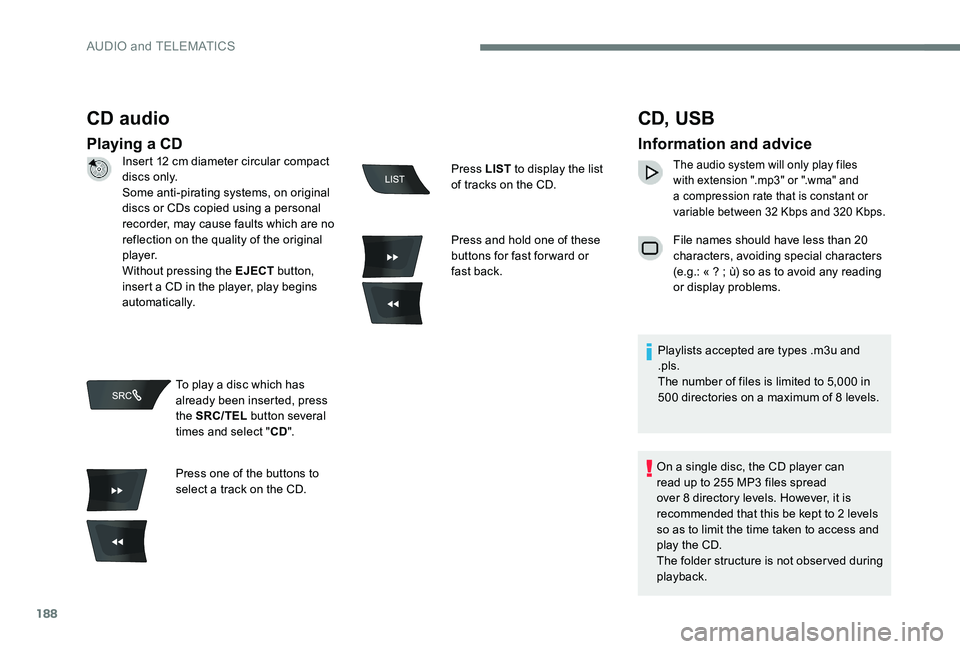CITROEN C-ELYSÉE 2017 Handbook (in English)
Manufacturer: CITROEN, Model Year: 2017, Model line: C-ELYSÉE, Model: CITROEN C-ELYSÉE 2017Pages: 306, PDF Size: 9.34 MB
Page 181 of 306

179
Engines and
specifications
The engine specifications (displacement, max.
power, max. speed, energy, CO
2 emissions,
etc.) associated with your vehicle are
mentioned in the registration certificate, and in
the commercial documents.
These characteristics correspond to the values
type-approved on a test bed, under conditions
defined in European legislation (Directive
1999/99/EC).
For more information, contact a
CITROËN
dealer or a qualified workshop.
Weights and towed
loads
The weights and towed loads relating to your
vehicle are stated in the registration certificate,
and in the sales documentation.
These values are also shown on the
manufacturer's nameplate or label.
For more information, contact a
CITROËN
dealer or a qualified workshop.
The mass in working order is equal to the
weight when empty + driver (75 kg).
The GTW values and the towable loads
listed are valid for a maximum altitude of
1,000
additional metres.
The weight of the braked trailer can be
increased, within the GTW limit, if the GV W
of the towing vehicle is reduced by an equal
amount.
The recommended nose weight corresponds
to the weight permitted on the tow-bar
(dismantlable with or without a tool).
GV W: Gross vehicle weight, the maximum
authorised vehicle weight.
GT W: Gross train weight High ambient temperatures may result
in a reduction in the per formance of the
vehicle to protect the engine. When the
ambient temperature is above 37°C, limit
the weight towed.
Towing with a towing vehicle which is only
slightly laden may negatively affect its
handling.
Towing a trailer increases the braking
distance.
The speed of a towing vehicle must not
exceed 62 mph (100 km/h) (comply with
the legislation in force in your country).
When the ambient temperature is high,
leaving the engine running for 1 to
2
minutes after stopping the vehicle to
allow it to cool is recommended.
9
Technical data
Page 182 of 306

180
Petrol
EnginesPureTech 82PureTech 82 S&S V T i 115
Gearboxes Manual 5-speed
(BVM5) Electronic (5-speed)
(ETG5) Manual 5-speed
(BVM5) Automatic 6-speed
( E AT 6)
Code EB2 F MAEC5 F
Version variant types: DD... HMZ6HMZ6/PS NFP0
NFP6NFPT
Capacity (cm
3) 1,1 9 91,1 9 9 1,5 87
Max power: EU standard (kW)* 6060 85
Fuel Unleaded 91 RON to
98 RON Unleaded 91 RON to
98 RON Unleaded 91 RON to 98 RON
Braked trailer (within the GTW limit)
on a 10% or 12% gradient 450
500 750
Unbraked trailer 450450 580
Recommended towing bar weight 5555 55
* The maximum power corresponds to the value type approved on a test bed, under conditions defined by European legislation (Directive 1999/99/EC).
Technical data
Page 183 of 306

181
Diesel
EngineHDi 92BlueHDi 100
Gearboxes Manual 5-speed
(BVM5) Manual 5-speed
(BVM5)
Code DV6 DM (euro 4)DV6 DDV6 FD
Version variant types: DD... 9HJC9HP0BHY6
Capacity (cm
3) 1,5 6 01,5 6 0
Max power: EU standard (kW)* 6873
Fuel DieselDiesel
Braked trailer (within the GTW limit)
on a 10% or 12% gradient 750
750
Unbraked trailer 580580
Recommended towing bar weight 5555
*
T
he maximum power corresponds to the value type approved on a engine bench, under conditions defined by European legislation (Directive
1999/99/EC).
9
Technical data
Page 184 of 306

182
Dimensions (in mm)
Technical data
Page 185 of 306

183
Identification markings
The vehicle may be originally equipped
with tyres with higher load and speed
indices than those indicated on the label,
without affecting inflation pressure.
Various visible markings for the identification of your vehicle.
A
Vehicle Identification Number (VIN)
under the bonnet.
This number is engraved on the bodywork
near the passenger compartment filter.
B Vehicle identification number on the
dashboard.
The number is recorded on a label, visible
through the windscreen.
C Tyre/paint label.
This label is affixed to the centre pillar on
the driver’s side.
It bears the following information:
-
T
he tyre pressures, for unladen and
laden conditions.
-
T
he tyre sizes.
-
T
he spare tyre inflation pressure.
-
T
he paint colour code. Low tyre pressure introduces the risk of a
burst tyre.
D
Manufacturer's label.
The number is indicated on a self-
destroying label affixed to the lower part
of the right hand centre pillar. Checking tyre pressures
The tyre pressures should be checked when
cold at least monthly.
The pressures given on the label are valid for
cold tyres. If you have driven for more than
10
minutes or more than 6 miles (10 kilometres)
at more than 30 mph (50 km/h), the tyres will be
warm. In this case 0.3 bar (30 kPa) should be
added to the pressures given on the label.
Never reduce the pressure of a warm tyre.
Low tyre pressures increase fuel
consumption.
9
Technical data
Page 186 of 306

184
BACK
VOL+
TA
Audio system /
Bluetooth
Your audio system is coded in such a way that
it will only operate in your vehicle.
First steps
Adjusting the volume.
On / Off
TA (Traffic Announcements)
on/of f.
Long press: access to type
of information.
Select the source:
Radio, CD, AUX, USB,
Streaming.
Accept an incoming call.
Manual step by step search
up / down for radio stations.
Select previous / next MP3
track.
Select previous/next folder /
genre / artist / playlist of the
USB device.
Scroll in a list.
Access to the main menu. Automatic search for a lower/
higher radio frequency.
Select previous / next CD,
USB, streaming track.
Scroll in a list.
Select preset radio station.
Long press: preset a radio
station.
Abandon the current
operation.
Go up one level (menu or
folder).
Confirm or display contextual
menu.
Display the list of stations
received, the CD/MP3 tracks
or folders.
Long press: manage the
classification of MP3/ WMA
files / update the list of
stations received.
As a safety measure, the driver must
only carry out operations which require
sustained attention when the vehicle is
stationary.
To avoid discharging the battery, the audio
system may switch off after a few minutes
if the engine is not running.
AUDIO and TELEMATICS
Page 187 of 306

185
Adjust audio settings: sound
ambience, treble, bass,
loudness, distribution, left/
right balance, front/rear
balance, automatic volume.
Select the screen display
mode, between:
Full screen: Audio (or
telephone if call in progress)
/
In a window: Audio (or
telephone if call in progress)
- Time or Trip computer.
Long press: black screen
(DARK).
Select AM / FM wavebands.
Steering mounted controls
Radio: automatic search for lower
frequency.
CD /MP3 / USB: selection of the
previous track.
CD / USB: press and hold: fast back.
Skip in the list.
Change the audio source.
Confirm a selection.
Call/end call on the telephone.
Press for more than 2 seconds:
access telephone main menu.
Radio: automatic search for a higher
frequency.
CD / MP3 / USB: select the next
track.
CD / USB: press and hold: fast
forward.
Skip in the list.
Increase volume.
Decrease volume.Mute on: cut the sound by
simultaneously pressing the volume
up and down buttons.
Radio: select the previous / next
preset radio station.
USB: select the genre / artist /
folder from the list depending on
classification.
Select the previous / next item in a
menu.
.
AUDIO and TELEMATICS
Page 188 of 306

186
Main menu
Screen C
"Multimedia ": Media settings, Radio
settings.
" Telephone ": Call, Directory
management, Telephone
management, Hang up.
" Trip computer ": Warning log.
" Bluetooth connection ":
Connections management, Search
for a device.
" Personalisation-configuration ":
Define the vehicle parameters,
Choice of language, Display
configuration, Choice of units, Date
and time adjustment.
Audio
Radio
Selecting a station
The external environment (hills, buildings,
tunnels, basement car parks, ...) may
block reception, including in RDS mode.
This is a normal effect of the way in
which radio waves are transmitted and
does not indicate any failure of the audio
equipment.
Press the SRC/TEL button
repeatedly to select the
radio.
Press BAND to select a
waveband. Press LIST
to display the
list of stations received, in
alphabetical order.
Select the desired radio
station by turning the thumb
wheel then confirm by
pressing.
A press changes to the next
or previous letter (e.g. A, B,
D, F, G, J, K, ...).
A long press on LIST builds
or updates the list of stations;
audio reception is cut
m o m e nt a r i l y.
AUDIO and TELEMATICS
Page 189 of 306

187
TA
RDS
RDS, if displayed, makes it possible
to continue listening to the same radio
station using the alternative frequencies
function. However, in certain conditions,
coverage of an RDS station may not be
assured throughout the entire country
as radio stations do not cover 100% of
the territory. This explains the loss of
reception of the station during a journey.With the radio displayed on the
screen, press the thumb wheel to
display the contextual menu.
Select "RDS" and confirm to save.
" RDS " is displayed in the screen.
Play TA messages
The TA (Traffic Announcement) function
gives priority to TA alert messages.
To operate, this function needs good
reception of a radio station that carries
this type of message. When a traffic
report is transmitted, the current audio
source (Radio, CD, USB, ...) is interrupted
automatically to play the TA message.
Normal play of the media previously
playing is resumed at the end of the
message.
Press TA to activate or deactivate
the reception of traffic messages.
Display TEXT INFOS
Text info is information transmitted by
the radio station related to the current
programme or song.
Screen C
With the radio displayed on the
screen, press OK to display the
contextual menu.
Turn the thumb wheel to select
‘’ R ADIO TEXT '', press to save.
.
AUDIO and TELEMATICS
Page 190 of 306

188
CD audio
Playing a CD
CD, USB
Information and advice
The audio system will only play files
with extension ".mp3" or ".wma" and
a compression rate that is constant or
variable between 32 Kbps and 320 Kbps.
File names should have less than 20
characters, avoiding special characters
(e.g.: « ? ; ù) so as to avoid any reading
or display problems.
Playlists accepted are types .m3u and
.pls.
The number of files is limited to 5,000 in
500 directories on a maximum of 8 levels.
On a single disc, the CD player can
read up to 255 MP3 files spread
over 8 directory levels. However, it is
recommended that this be kept to 2 levels
so as to limit the time taken to access and
play the CD.
The folder structure is not observed during
playback.
Insert 12 cm diameter circular compact
di s c s o n l y.
Some anti-pirating systems, on original
discs or CDs copied using a personal
recorder, may cause faults which are no
reflection on the quality of the original
p l aye r.
Without pressing the EJECT
button,
insert a CD in the player, play begins
automatically.
To play a disc which has
already been inserted, press
the SRC/TEL button several
times and select " CD".
Press one of the buttons to
select a track on the CD. Press LIST
to display the list
of tracks on the CD.
Press and hold one of these
buttons for fast for ward or
fast back.
AUDIO and TELEMATICS